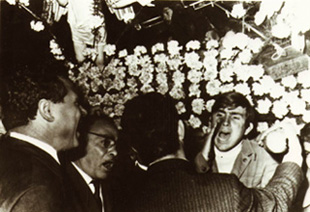| During the days of the Holy Week we have the chance to
witness one of the few repertoires of traditional multivocal
singing still in use in nearly all of the Sicilian territory. I
am referring to the liturgical or para-liturgical repertoire
which, as will be seen later on, presents some particular
characteristics of which there are actually no traces in the
profane repertoire. The polyphonic repertoire, whose high point is to be found in the rites of the Holy Week, is performed almost exclusively by male groups, descendants of the brotherhoods or craftsmen’s guilds. Its musical peculiarity consists in being made up of pieces whose structure is said to be ad accordo (‘at chords’, i.e. in an chordal fashion). This requires the presence of one or more soloists who perform an autonomous melodic line and a chorus that accompanies this melodic line with a succession of chords. A further differentiation can be made within this repertoire:
|

Caltanissetta, Holy Thursday
2004 |
- Solo singing, with the accompaniment ad accordo (to which those songs in which two or three solo voices alternate in the performance also belong);
- Singing with two voices, with the accompaniment ad accordo, in which the solo voices sing in parallel with the melodic line.
These songs, linked to the ritual processional or liturgical contexts and passed down by way of the “professionalism” of the performers, can be attributed to 17th century models, even if “the elements that converge in forming the repertoire, the style, the performance style, the performers’ attitude and their ways of participating in the community exist between them in a largely conflicting manner” (R. Leydi 1991: 182).
|

Barcellona
Pozzo di Gotto, Good Friday, 1960 ca. |
Latin texts were frequently adopted before the Second Vatican Council, when Latin became part of the official Catholic liturgy; instead, in the other case, we come across texts in Italian or in Sicilian that narrate episodes concerning the Passion and the death of Christ, according to the apocryphal Gospels or in texts that are often vulgarisations of Latin texts (cfr. Giallombardo 1977; Macchiarella 1987, 1988, 1992, 1993; Sarica-Fugazzotto 1994, 1997, 2000).
|
|

